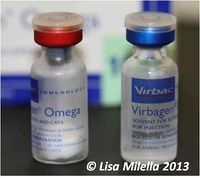Difference between revisions of "Other Medication for Oral Disease"
| Line 5: | Line 5: | ||
==Interferon== | ==Interferon== | ||
[[File:Interferon bottle.jpg|right|200px|thumb|Interferon <small>''© Lisa Milella 2013''</small>]] | [[File:Interferon bottle.jpg|right|200px|thumb|Interferon <small>''© Lisa Milella 2013''</small>]] | ||
| − | Interferons are [[cytokines]] that have '''anti-viral, antiproliferative and immunomodulatory effects'''. Virbagen®Omega is a recombinant omega interferon of feline origin (rFeIFN- ω) produced by genetic engineering. Virbagen®Omega is a Type 1 Interferon, closely related to the human alpha and beta interferons. Interferons bind to specific receptors on the plasma membrane of other cells. The binding activates a complex transcriptional cascade, leading to the up-regulation of greater than 20 cellular genes, producing an interferon-activated cell. IFN-induced proteins are numerous and each protein confers a new property to the cell. This may be antiviral, immune modulating or antiproliferative. The antiviral effect of an interferon-activated cell results from the induction of specific proteins which inhibit viral multiplication and viral protein synthesis. The antiproliferative effect of an interferon-activated cell results in regulation of the genes controlling cell division which can lead to the inhibition of cell proliferation and an antitumoral effect.<br><br> | + | Interferons are [[cytokines]] that have '''anti-viral, antiproliferative and immunomodulatory effects'''. Virbagen®Omega is a recombinant omega interferon of feline origin (rFeIFN- ω) produced by genetic engineering. Virbagen®Omega is a Type 1 Interferon, closely related to the human alpha and beta interferons. [[Interferons]] bind to specific receptors on the plasma membrane of other cells. The binding activates a complex transcriptional cascade, leading to the up-regulation of greater than 20 cellular genes, producing an interferon-activated cell. IFN-induced proteins are numerous and each protein confers a new property to the cell. This may be antiviral, immune modulating or antiproliferative. The antiviral effect of an interferon-activated cell results from the induction of specific proteins which inhibit viral multiplication and viral protein synthesis. The antiproliferative effect of an interferon-activated cell results in regulation of the genes controlling cell division which can lead to the inhibition of cell proliferation and an antitumoral effect.<br><br> |
The benefits of using Interferon in feline chronic gingivostomatitis (FCGS) have yet to be properly documented and studied but consensus is that there are significant benefits. Interferon is recommended as an adjunct to the other treatments. Initially the direction was to use systemic admission followed by daily oral dosage. Currently the recommendation is to give intralesional injections at the time of main treatment and then follow by oral dosage. | The benefits of using Interferon in feline chronic gingivostomatitis (FCGS) have yet to be properly documented and studied but consensus is that there are significant benefits. Interferon is recommended as an adjunct to the other treatments. Initially the direction was to use systemic admission followed by daily oral dosage. Currently the recommendation is to give intralesional injections at the time of main treatment and then follow by oral dosage. | ||
[[Category:Dental and Oral Medication]] | [[Category:Dental and Oral Medication]] | ||
| − | [[Category:To Do - Dentistry | + | [[Category:To Do - Dentistry preMars]] |
Revision as of 15:01, 9 September 2013
Steroids
Systemic steroids produce an excellent temporary improvement in oral diseases such as chronic gingivostomatitis but have significant side effects and lose their efficacy with repeat use. They should never be used as first line treatment and only be used for certain cases, following biopsy and initial treatment. Steroids also artificially improve the disease state making assessment at times very difficult. Used as a last resort.
Interferon
Interferons are cytokines that have anti-viral, antiproliferative and immunomodulatory effects. Virbagen®Omega is a recombinant omega interferon of feline origin (rFeIFN- ω) produced by genetic engineering. Virbagen®Omega is a Type 1 Interferon, closely related to the human alpha and beta interferons. Interferons bind to specific receptors on the plasma membrane of other cells. The binding activates a complex transcriptional cascade, leading to the up-regulation of greater than 20 cellular genes, producing an interferon-activated cell. IFN-induced proteins are numerous and each protein confers a new property to the cell. This may be antiviral, immune modulating or antiproliferative. The antiviral effect of an interferon-activated cell results from the induction of specific proteins which inhibit viral multiplication and viral protein synthesis. The antiproliferative effect of an interferon-activated cell results in regulation of the genes controlling cell division which can lead to the inhibition of cell proliferation and an antitumoral effect.
The benefits of using Interferon in feline chronic gingivostomatitis (FCGS) have yet to be properly documented and studied but consensus is that there are significant benefits. Interferon is recommended as an adjunct to the other treatments. Initially the direction was to use systemic admission followed by daily oral dosage. Currently the recommendation is to give intralesional injections at the time of main treatment and then follow by oral dosage.
